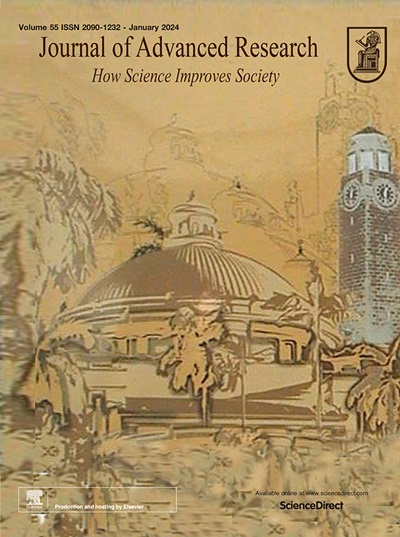GhGLDH35A gene-mediated ROS homeostasis and stomatal movement via the ascorbic acid pathway confers alkaline stress tolerance
IF 11.4
1区 综合性期刊
Q1 MULTIDISCIPLINARY SCIENCES
引用次数: 0
Abstract
Introduction
Ascorbic acid (AsA) is involved in plant responses to various abiotic stresses. However, its specific function in alkaline stress tolerance remains poorly understood. The L-galactono-1,4-lactone dehydrogenase (GLDH) gene is crucial for AsA synthesis, yet the precise role of GLDH in modulating plant resistance to alkaline stress has not been comprehensively characterized.Objectives
To investigate the role of GLDH genes in enhancing tolerance to alkaline stress.Methods
Bioinformatics analysis of the GLDH gene family members was conducted, and an evolutionary tree was constructed using MEGA software. Cis-acting elements and gene structures were analyzed using TBtools. Gene expression levels were quantified by qRT-PCR, while the function of the GhGLDH35A gene was validated through VIGS (Virus-induced gene silencing) in cotton, heterologous overexpression in Arabidopsis thaliana, and complementation assays in yeast.Results
Our study investigated the effects of salt-alkaline stress on cotton and found that alkaline stress caused significantly more severe damage than salt stress. The GLDH family genes were identified and analyzed, revealing a high degree of evolutionary conservation. Most GhGLDH genes exhibited a positive response to alkaline stress and were regulated by light. Among them, GhGLDH35A, which is highly expressed within the GLDH family, was found to play a key role in conferring tolerance to alkaline stress. Subcellular localization analysis indicated that GhGLDH35A is localized in the mitochondria. Silencing of GhGLDH35A in cotton resulted in reduced tolerance to alkaline stress, disruption of ROS homeostasis, and impairment of photosynthesis and stomatal function. Conversely, overexpression of GhGLDH35A in Arabidopsis enhanced alkaline stress resistance by elevating AsA levels, increasing antioxidant enzyme activities to enhance ROS scavenging, sustaining photosynthesis, and promoting stomatal closure. Furthermore, heterologous expression of GhGLDH35A in yeast also improved its tolerance to alkaline stress.Conclusions
GhGLDH35A positively regulates alkaline stress tolerance by enhancing antioxidant defenses and regulating stomatal movement.

GhGLDH35A基因通过抗坏血酸途径介导的ROS稳态和气孔运动赋予碱性胁迫耐受性
抗坏血酸(AsA)参与植物对各种非生物胁迫的反应。然而,其在碱胁迫耐受性中的具体功能尚不清楚。l -半乳糖-1,4-内酯脱氢酶(GLDH)基因对AsA的合成至关重要,但GLDH在调节植物抗碱性胁迫中的确切作用尚未得到全面的研究。目的探讨GLDH基因在增强碱性胁迫耐受性中的作用。方法对GLDH基因家族成员进行生物信息学分析,并利用MEGA软件构建进化树。使用TBtools分析顺式作用元件和基因结构。通过qRT-PCR定量表达GhGLDH35A基因的表达水平,并通过棉花的VIGS(病毒诱导基因沉默)、拟南芥的异源过表达和酵母的互补实验验证GhGLDH35A基因的功能。结果研究了盐碱胁迫对棉花的影响,发现碱胁迫对棉花的危害明显大于盐胁迫。对GLDH家族基因进行了鉴定和分析,发现其具有高度的进化保守性。大多数GhGLDH基因对碱性胁迫表现出正响应,并受光照调节。其中,在GLDH家族中高表达的GhGLDH35A在耐碱胁迫中起关键作用。亚细胞定位分析表明GhGLDH35A定位于线粒体。GhGLDH35A基因的沉默导致棉花对碱性胁迫的耐受性降低,活性氧稳态被破坏,光合作用和气孔功能受损。相反,过表达GhGLDH35A在拟南芥中通过提高AsA水平、增加抗氧化酶活性来增强对ROS的清除、维持光合作用和促进气孔关闭,从而增强了对碱性胁迫的抗性。此外,在酵母中外源表达GhGLDH35A也提高了其对碱性胁迫的耐受性。结论ghgldh35a基因通过增强抗氧化防御和调节气孔运动积极调节碱性胁迫耐受性。
本文章由计算机程序翻译,如有差异,请以英文原文为准。
求助全文
约1分钟内获得全文
求助全文
来源期刊

Journal of Advanced Research
Multidisciplinary-Multidisciplinary
CiteScore
21.60
自引率
0.90%
发文量
280
审稿时长
12 weeks
期刊介绍:
Journal of Advanced Research (J. Adv. Res.) is an applied/natural sciences, peer-reviewed journal that focuses on interdisciplinary research. The journal aims to contribute to applied research and knowledge worldwide through the publication of original and high-quality research articles in the fields of Medicine, Pharmaceutical Sciences, Dentistry, Physical Therapy, Veterinary Medicine, and Basic and Biological Sciences.
The following abstracting and indexing services cover the Journal of Advanced Research: PubMed/Medline, Essential Science Indicators, Web of Science, Scopus, PubMed Central, PubMed, Science Citation Index Expanded, Directory of Open Access Journals (DOAJ), and INSPEC.
 求助内容:
求助内容: 应助结果提醒方式:
应助结果提醒方式:


